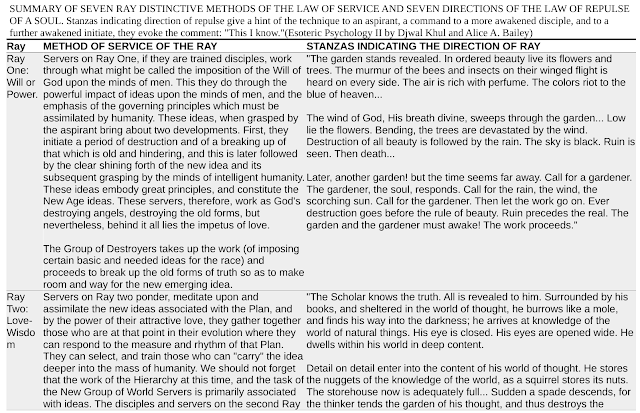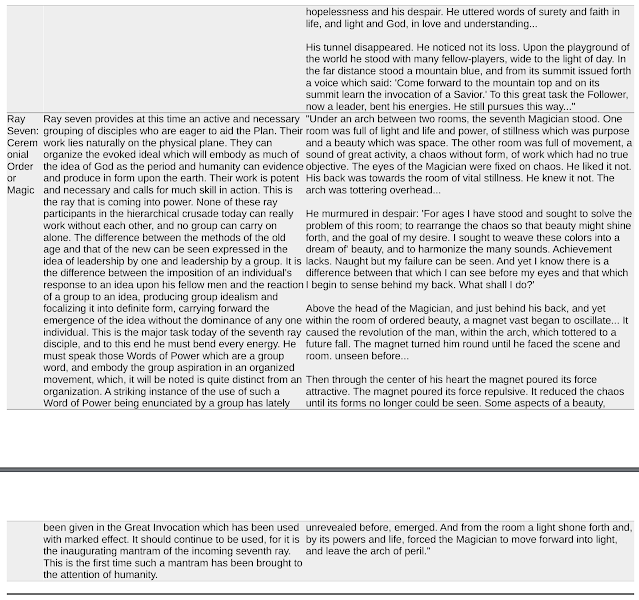Seven Rays Methods of Service and Repulse
Today we summarize in the next table, statements covering the seven rays methods of the law of service (3rd law of Soul) and the direction of law of repulse to the psychological problem of Desire (4th law of soul) , from the volume 'Esoteric Psychology II by Djwal Khul and Alice Bailey'.
Service can be defined as the spontaneous effect of soul contact. Service is not a quality or a performance; it is not an activity towards which people must strenuously strive, nor is it a method of world salvage. Service is a life demonstration. It is a soul urge. It is the outstanding characteristic of the soul, just as desire is the outstanding characteristic of the lower nature. It is group desire, just as in the lower nature it is personality desire. It is the urge to group good. It cannot, therefore, be taught or imposed upon a person as a desirable evidence of aspiration, functioning from without and based upon a theory of service.
Thus authentic service is essentially difficult as it requires definite and fixed contact with soul. It involves so much sacrifice of time and of interest and of one's own ideas, it requires exceedingly hard work, because it necessitates deliberate effort, conscious wisdom, and the ability to work without attachment. These qualities are not easy of attainment by the average aspirant.
How does one distinguish a true server ? By his 3 major characteristics :
1. Harmlessness: He will actively refrain from those acts and that speech which might hurt or cause any misunderstanding with the group.
2. A willingness to let others serve as seems best to them. He is helping others to "stand in spiritual being", as he himself is learning to stand. He aids the individual brother to express his service in his chosen field as he desires to express it, and not as the onlooking helper deems that he should do it.
3. Joyfulness: This takes the place of criticism (that dire creator of misery) and is the silence that sounds.
The daily pledge whole heartedly and consciously of a true server is - "I play my part with stern resolve; with earnest aspiration; I look above, I help below; I dream not, nor I rest; I toil; I serve; I reap; I pray; I am the Cross; I am the Way; I tread upon the work I do, I mount upon my slain self; I kill desire, and I strive, forgetting all reward. I forego peace; I forfeit rest, and, in the stress of pain, I lose myself and find Myself and enter into peace. To all this I solemnly pledge myself, invoking my Higher Self."
There is a complete science of service which will come forth in the new age and the seven ray types will work in the ways briefly summarized in the table.
Next the law of repulse, is one which primarily begins to impress the divine purpose upon the consciousness of the
aspirant, and dictates to him those higher impulses and those spiritual decisions which mark his progress upon the Path. Note that to repulse a form, a situation or a condition may be the evidence of spiritual love in the agent of repulsion.
Underlying the entire psychological problem of humanity as a whole lies that major attitude towards existence which we characterise as Desire. All lesser complexities are based upon, subservient to, or are emergent from, this basic urge. The seven stanzas summarized in a table below gives a hint (if one is an aspirant) of the technique to which one will be exposed; if one has passed further on the Way, they will give one a command which, as a disciple with spiritual insight one will obey, because one is awakened; if one is an initiate, they will evoke the comment: "This I know."









Comments
Post a Comment